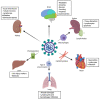Deciphering SARS-CoV-2 Virologic and Immunologic Features
- PMID: 32824753
- PMCID: PMC7460647
- DOI: 10.3390/ijms21165932
Deciphering SARS-CoV-2 Virologic and Immunologic Features
Abstract
Severe acute respiratory syndrome coronavirus (SARS-CoV)-2 and its associated pathology, COVID-19, have been of particular concerns these last months due to the worldwide burden they represent. The number of cases requiring intensive care being the critical point in this epidemic, a better understanding of the pathophysiology leading to these severe cases is urgently needed. Tissue lesions can be caused by the pathogen or can be driven by an overwhelmed immune response. Focusing on SARS-CoV-2, we and others have observed that this virus can trigger indeed an immune response that can be dysregulated in severe patients and leading to further injury to multiple organs. The purpose of the review is to bring to light the current knowledge about SARS-CoV-2 virologic and immunologic features. Thus, we address virus biology, life cycle, tropism for many organs and how ultimately it will affect several host biological and physiological functions, notably the immune response. Given that therapeutic avenues are now highly warranted, we also discuss the immunotherapies available to manage the infection and the clinical outcomes.
Keywords: COVID-19; SARS-CoV-2; immunopathology; immunotherapy; virus biology.
Conflict of interest statement
The authors declare no conflict of interest.
Figures





References
Publication types
MeSH terms
Substances
LinkOut - more resources
Full Text Sources
Miscellaneous

